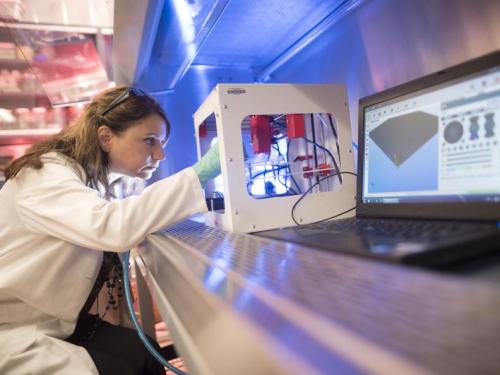
Allevi Blog
User Update: Groundbreaking Research at UMN
- Updated on May 9, 2022
Allevi customer, Dr. Angela Panoskaltsis-Mortari, speaks to the University of Minnesota Health Blog about her ground-breaking bioprinting research at UMN using the Allevi BetaBot. Read on for the full story:
“The print head of a 3-D printer scrolls back and forth with a whir, laying down a line of translucent gel 0.15 millimeters thick. A flash of blue light immediately cures the material, the first of 92 separate layers.
Soon, the outline of a nose appears.
‘A nose this size will take about two hours,’ said Angela Panoskaltsis-Mortari, PhD, a transplant specialist and the head of the University of Minnesota’s new 3-D Bioprinting Facility.
A three-dimensional life-sized nose is just a showpiece to test the new printer, the only 3-D bioprinter on campus. But Panoskaltsis-Mortari predicts that in just a few years, the facility and a few others around the country will be churning out basic body parts such as ears, skin, or blood vessels for transplantation. Some parts may even be manufactured with a patient’s own cells to avoid rejection by the immune system.
With the ability to print a structure that’s exactly the size and specifications a patient needs, bioprinting has the potential to transform regenerative medicine. ‘It becomes a part of personalized medicine,’ says Panoskaltsis-Mortari.

FROM THEORETICAL TO TANGIBLE
Bioprinting is just one of the more revolutionary medical applications of burgeoning 3-D printing technology. In the last couple of years, 3-D printing has provided models for teaching and for designing medical devices. It has allowed doctors to better communicate with patients and parents about surgical procedures. And it has replicated natural human systems such as hearts and blood vessels to help doctors evaluate surgical techniques.
Three-dimensional printing, sometimes called additive manufacturing, fabricates objects directly from digital files. Software slices a 3-D image into dozens, hundreds, or even thousands of layers. It then instructs the printer to lay down layer after layer of material, usually some kind of molten plastic or polymer hardened by exposure to ultraviolet light.
University of Minnesota Health Pediatric Cardiothoracic Surgeon Robroy MacIver, MD, MPH, who sees patients at University of Minnesota Masonic Children’s Hospital, 3-D-prints a life-sized heart from his young patient’s MRI or CT scans. Then he can describe to the parents the defect and the surgery he is about to perform.
‘Showing them a CT scan on the screen, you lose a little bit—the size for one thing, how small a vessel is or how small the heart is,’ MacIver said. ‘When you have the actual heart printed, you can show them what you’re talking about. It’s much more tangible.’
BOOMING WITH POTENTIAL
For all the excitement about 3-D printing, the possibility of printing with lifelike organic material, including a patient’s own cells—called bioprinting—is perhaps most novel.
Bioprinting may solve several problems, such as chronic shortages of organs and tissue for implants, and poor genetic matches between donor and patient that lead to tissue rejection.
With 3-D bioprinting, transplantable tissues and simple structures will be made to order and printed on demand, perhaps seeded with the patient’s own cells.
‘Any shape you want, any size you want,’ Panoskaltsis-Mortari said. ‘I’ve been thinking about it for many years, ever since I saw some of the first reports.’
Then a bioprinter fell into her lap. The young founders of Allevi gave printers at deeply discounted prices to 20 research facilities around the world — including Panoskaltsis-Mortari’s lab.
‘They wanted to see what people would come up with,’ she says. ‘It’s a nice strategy. That way, people are free to follow whatever scientific approaches they’re taking.’
Her team is beginning work on 3-D-printed pieces of an artificial esophagus and trachea to sew into an animal such as a pig.
There are still plenty of problems to solve. What kind of biocompatible material will be tough enough to hold sutures? Will it support cell growth? What’s the best way to seed cells on the piece? How thick can a printed part be?
‘Hopefully, we can coax blood vessels to grow into it, to provide nutrients to it,’ Panoskaltsis-Mortari said.
How long before 3-D-printed vessels, tubes, skin, and other simple body parts will be printed and implanted in humans? Just a few years, she predicts. ‘Not long.’”

